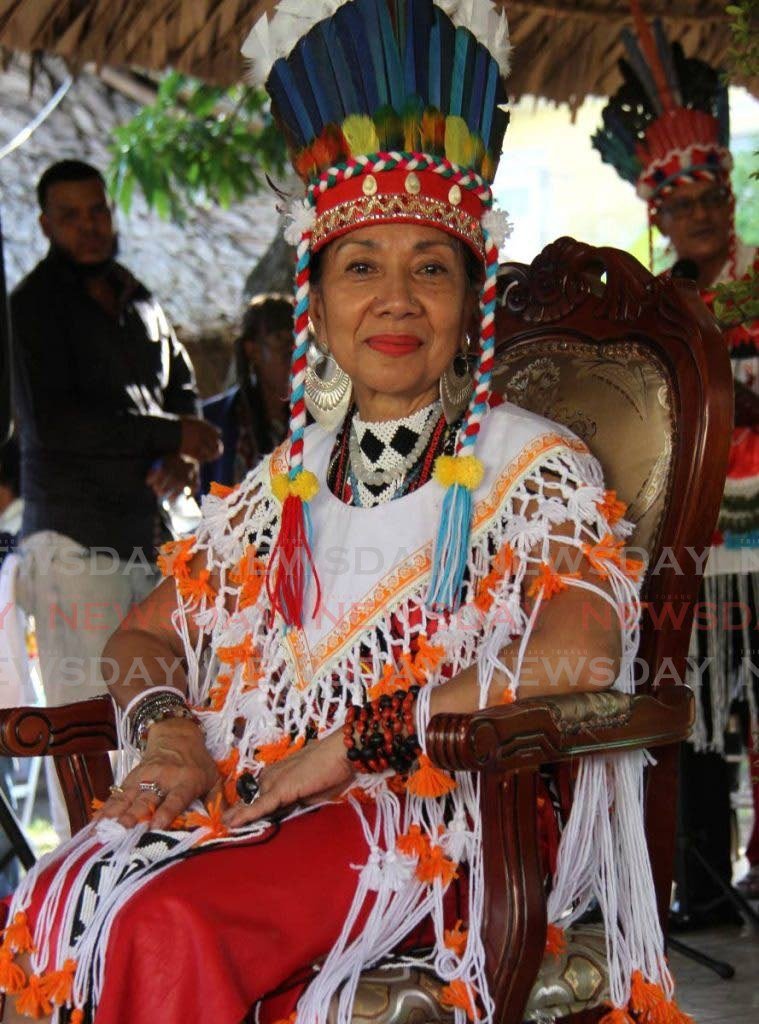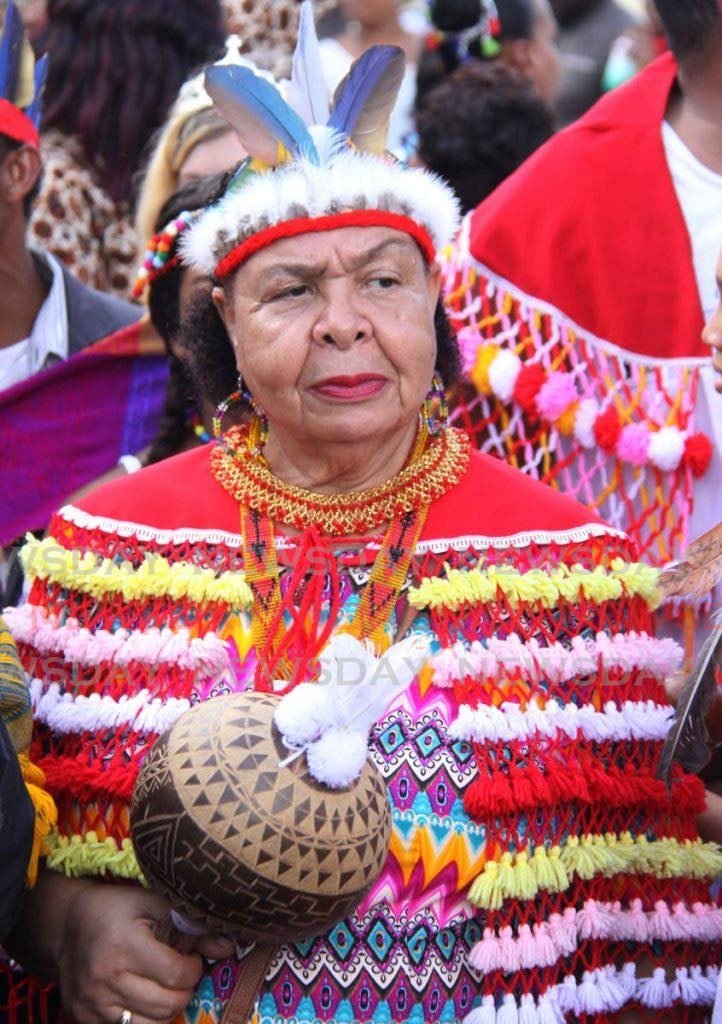Debunking the myth of invisible First People

There is a myth that the culture, identity and traditions of the First People have been wiped out of history because of colonisation.
Coined in 1902 by the American Anthropological Association, Amerindian is a portmanteau for American Indian to describe the First People of the Americas. Trinidad and Tobago is the oldest settled island in the Caribbean. When the Spanish rediscovered TT, they named the indigenous people Arawaks and Caribs.
Psyche Gonzales is an MSc student in gender and development studies at UWI,St Augustine. Last November she held a graduate seminar to discuss her research on resisting the myth of erasure in accounts of First People women in Arima via a Zoom conference.
“I have always been troubled by the persistence of the lie that indigenous people were erased during colonialism. I use the term 'indigenous' to refer exclusively to pre-colonial inhabitants of the islands and their descendants…The myth of erasure has been instrumental in the silencing and marginalisation of the First People,” she declared.
Gonzales, from Arima, has been researching this topic for nine months. As a member of the First People community, she has access to members and records. She localised her research to Arima not only because she is a part of the community, but because the Santa Rosa First People are the only First People recognised by the state.
Her research participants were both registered and unregistered members of the First People community. Originally, she intended to do 15 face-to-face interviews but had to alter her approach because of covid19. Over three months she interviewed eight women. She also collected data from women over WhatsApp and e-mail. However, two did not submit their consent forms, so her sample set was reduced to six.
MORE THAN WORDS
“Active listening was integral to my ethics of care. Throughout the interview process, I paid attention to silences, facial expressions, emphasis, and gestures as these non-verbal cues could provide insight into the respondent’s values, beliefs, and experiences.”
She asked each participant to bring an object meaningful to their First People identity such as a family photo, recipe, bush medicine, newspaper or personal essay.
“I used contextualisation to make sense of the historical and socio-cultural contexts of the data collected.”
Trinidad was called Iere by the First People. When Christopher Columbus rediscovered the island in 1498 he renamed it after the Trinity. The indigenous people and conquistadors battled for Trinidad. In an attempt to peacefully convert the indigenous people, King Ferdinand II sent Catholic missionaries to Trinidad to convert them. Two Dominican friars went to Trinidad in 1513 and were killed by the Fist People. Only after 32 years of Columbus' arrival did the Spanish settle on the island.
This imposing of religious and cultural beliefs by the Spanish colonisers caused a marginalisation of the First People who, to this day, still conduct a conscious act of silencing and erasure.
“In addition to the silences that are imposed on the First People by external others, various forms of silencing are practised within the community itself. I noted two main types in the data. The first is silence as resistance.”
ACTS OF RESISTANCE
This self-imposed silence of the First People, Gonzales said, began as a response to persecution by colonial authorities for their religious and social practices, and rituals and memories were passed down in secret. Because secrecy became ingrained in the First People’s culture, generational knowledge was not freely available or accessible.
“In my family, for example, knowledge of rituals and remedies varies between my maternal and paternal branches.”
Self-policing was another form of silencing she observed. Some women indicated that they consciously refrained from engaging in discussions about their indigeneity.
“Women police themselves as a defense mechanism, to protect themselves from pain. These women refused to challenge misrepresentations of indigenous people, either from resignation to the status quo or fear of reprisal.”

This silence, she said, inevitably led to a further marginalise of the First People community.
“Commitment to a decolonial revision of history requires indigenous people to abolish these practices of silencing.”
The Santa Rosa First People give little stock to written history of the indigenous population because it was written by outsiders who reinforced “damaging colonial stereotypes.”
“Instead, oral history and demonstration remain the primary methods of knowledge production and transmission. The reluctance of the First People to produce written works can be viewed as a continuation of silence as resistance, silence thrown against a superior silence.”
However, she saw participants using writing as an act of resistance.
“One participant is adding indigenous knowledge sources to her academic research. Another uses personal essays to document the contemporary lives of indigenous people.”
The First People population is a mixed-race group.
“Sexism, racism, and colourism continue to operate in all layers of local society. I am a racially mixed woman of First People descent. My physical appearance and my performance of gender afford me privileges not shared with those members of my family who look or present differently than I do.
“Within the First People community, phenotype, gender and sexuality influence social status and inevitably result in an unequal distribution of social power.”
MARKS OF IDENTIY
Like gender, race is a visual marker of identity. Gonzales said this perception of race determines a person’s social standing and social power. Physical appearance and skin tone varies in the First People population – even in the same family. This causes them to experience racism and colourism in different ways.
Because of the myth of erasure of the indigenous population, the “radical mixedness” causes people to doubt if the person is even part of the First People.
“This has resulted in cultural dissonance and complicated the formation of social identity, as evidenced in the responses of research participants.”
However, she observed First People women associate indigeneity with lineage and cultural practices rather than physical appearance or “arbitrary blood quotas.”
“They do not claim indigeneity despite mixed racial ancestry. Instead, they embrace indigeneity whilst acknowledging the complexities implicit in this choice.”
Because of miscegenation, Gonzales said there are far more descendants of the First People than those who claim indigenous identity.
Some claimed a European identity because they had physical similarities to white people. Others resemble Africans or East Indians and claim those “majority” identities.
“As a member of the majority, they can access more social power than as a member of a minority population. However, claims to identity are not fixed. Social location is constantly mediated.
“It is not uncommon in the First People community for individuals to claim different identities based on the situation to access or exercise power.”
One participant she calls Ann
identifies as Afro-Trinidadian. Ann has brown skin and curly black hair and appears to have mixed racial ancestry. Ann submitted a photo of her maternal grandmother, who was a First People woman with light brown skin and straight black hair.
Ann grew up in Arima surrounded by family and neighbours who were also First People, but she identified as Afro-Trinidadian because she was raised during the Black Power movement by her mother, who looked predominantly black.
Ann’s decision to acknowledge her First People identity came after meeting other indigenous people abroad. Ann also looks like her grandmother and that helped her accept her indigenous heritage and identity.
In an interview Ann told Gonzales: “I used to say…I am African…(but) I come to the realisation I’m not an African… I’m really an indigenous woman because there is where I come from…We don’t really know where we come from in Africa…My eyes opened up by travelling and meeting other people and even meeting indigenous people and the connections I feel with them that I now focus on indigenous.”
Gonzales compared Ann’s photo to one of her own family, specifically her maternal first cousins.
“Some have predominantly African features, others East Indian. Some look like the idealised Indian, others are misidentified as Chinese. We are all descendants of the First People, but we do not all identify as such.”
She noticed the pandemic reaffirmed the indigenous identity of most women in the study in an “unexpected way.”
“First People’s culture has always been tied to ways of knowing about the land. Conservation, respect for the environment, and the knowledge of how to live off the land are considered tenets of First People’s culture. As paranoia about potential economic collapse increased, they took comfort in the knowledge that as indigenous women they are prepared for whatever comes next.”
She also observed the women had a strong sense of responsibility to their ancestors and to future generations, to share and pass on First People's
knowledge.
“The archival objects that they submitted were significant not only because they had been passed down from the ancestors but because these women are determined to pass them on to the next generation.”
In Arima, Catholicism and Catholic symbolism are intertwined with First People’s culture. Many activities of the Santa Rosa First People’s community are done under the patronage of the church.
The Santa Rosa Carib Queen was sanctioned by the church in the 1800s. She is considered the keeper of traditions and remains the most recognisable representation of the First People.
Gonzales’ project demonstrates that First People women challenge the myth of Indigenous erasure by preserving and passing on First People’s culture.
“By claiming First People’s identity despite narratives of erasure and racialised discourse First People women are contributing to the decolonisation of knowledge production in the Caribbean.”
Indigenous Caribbean feminism, Gonzales said, facilitates the deconstruction of colonial systems by presenting a pre-colonial Caribbean philosophy and creates space for women in other marginalised ethnic communities.
“I hope to expand the scope of this project by engaging participants from indigenous communities throughout TT in future studies. By sharing our stories, we will illuminate indigenous epistemologies and bury the lie of erasure.”
Gonzales hopes to submit her full MSc research project by the end of January.


Comments
"Debunking the myth of invisible First People"